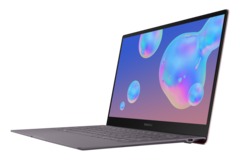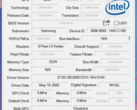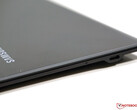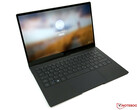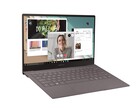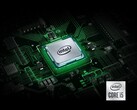La versión Intel del Samsung Galaxy Book S por 1129 euros es ligeramente más cara que la versión ARM recientemente revisada (1099 euros). La mayor diferencia es, obviamente, el procesador, pero hay más cambios cuando se mira más de cerca y nos hubiera gustado ver algunas de las características del ARM Galaxy Book S.
Con 940 gramos, la versión Intel del Galaxy Book S es incluso un poco más ligera, pero no notarás la diferencia ni siquiera en una comparación directa. Sin embargo, el modelo Intel también viene con la aplicación de configuración de Samsung precargada, que ofrece algunas características útiles. Entre ellas se encuentra la limitación de la carga máxima de la batería si utilizas el dispositivo principalmente con un adaptador de corriente o el modo exterior para la pantalla táctil. La pantalla es básicamente la misma pantalla táctil de 1080p de BOE y la luminancia en el centro también es compatible con 380 nits. Sin embargo, una vez que se activa el modo exterior (a través de app o Fn+O), la luminancia máxima se incrementa en casi un 75% hasta 655 nits. Esto puede ser muy útil en el exterior en combinación con la pantalla brillante. Obviamente, también afectará al tiempo de funcionamiento de la batería, pero todavía tenemos que probar esto.
Intel Lakefield Hybrid Processor
We have already covered the specs and the performance of the new Lakefield processor in a separate article. Compared to the Snapdragon 8cx processor of the ARM model, the CPU performance is a bit better, but the graphics performance is almost on the same level. The x86 processor is much more convenient in practice since 64-bit apps are supported. While you have to check if there are suitbale versions for the ARM processor, you can just use the Intel Galaxy Book S like a regular laptop.
The subjective performance impression is very good for common tasks. We did not notice any limitations or delays when we installed applications and benchmarks. The Intel CPU is also passively cooled, so there is no annoying fan.
The Intel processor also includes a faster Wi-Fi 6 module (AX200), but Samsung does not include an LTE modem, even though Intel's XMM 7560 is supported by the Lakefield processor. This is a big drawback compared to the ARM version and we cannot really understand this decision for such a mobile device.
Keyboard Illumination and Battery Runtime
Our criticism of the keyboard illumination (in this case white instead of green) also applies for the Intel model. We did find the brightness sensor (which only controls the keyboard illumination) on the Intel model in the lower right display bezel, but the basic problem is the same, because you cannot deactivate the sensor and control the illumination manually. If it is not completely dark, the illumination is just turned off automatically. You can at least change the duration before the illumination is turned off when you do not type. There should be an option to control the illumination manually and not just via sensor.
The Intel model uses a bit more power in almost every scenario, which is also noticeable in the battery runtime. Samsung advertises a lower runtime, and our results so far confirm that: The load test runs for almost 4 hours (without outdoor mode), 2 hours less than the ARM model. The Wi-Fi test at 150 nits is still running, but it should result in about 11-12 hours compared to more than 16 hours for the ARM model.
Top 10 Análisis
» Top 10 Portátiles Multimedia
» Top 10 Portátiles de Juego
» Top 10 Portátiles de Juego ligeros
» Top 10 Portátiles Asequibles de Oficina/Empresa
» Top 10 Portátiles de Juego Ligeros
» Top 10 Portátiles de Oficina/Empresa Premium
» Top 10 Estaciones de Trabajo
» Top 10 Subportátiles
» Top 10 Ultrabooks
» Top 10 Convertibles
» Top 10 Tablets
» Top 10 Tablets Windows
» Top 10 Tablets de menos de 250 Euros
» Top 10 Phablets (>5.5")
» Top 10 Smartphones
» Top 10 Smartphones (≤5")
» Top 10 Smartphones de menos de 300 Euros
» Top 10 Smartphones de menos de 120 Euros
» Top 10 Portátiles de menos de 1000 Euros
» Top 10 Portátiles de menos de 500 Euros
» Top 10 Portátiles de menos de 300 Euros
» Los Mejores Displays de Portátiles Analizados por Notebookcheck
First Impression - More convenient, but the lack of LTE does not make much sense
Intel's new Lakefield processor is a standard x86 processor, which means it supports 64-bit applications. This means you can just install any application without thinking about the compatibility. The subjective performance impression is okay and the implementation of the Wi-Fi 6 module is definitely good, but we cannot understand the lack of an LTE modem. This means you have to waive a big advantage of the Galaxy Book S ARM. The outdoor mode for the display is also a welcome feature, but we do not know why the ARM model does not get this mode, since it seems to be the exact same 1080p touchscreen.
We will perform our standard benchmarks and measurements over the next couple of days. Besides the performance of the new processor, we are especially eager to see the efficiency and the battery runtimes. We will also check the effects of the outdoor mode for the display.




